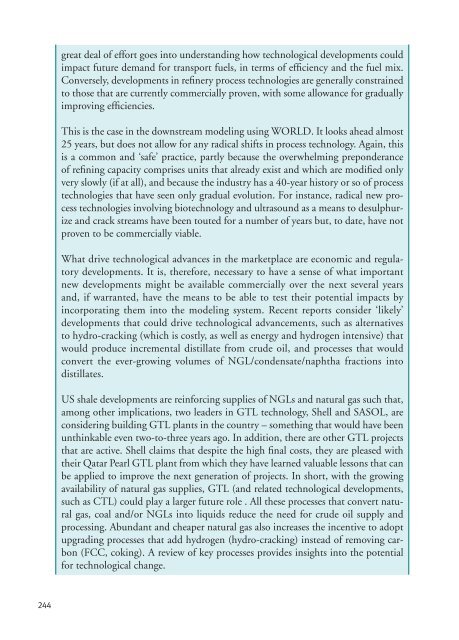World Oil Outlook - Opec
World Oil Outlook - Opec
World Oil Outlook - Opec
- TAGS
- world
- outlook
- opec
- www.opec.org
Create successful ePaper yourself
Turn your PDF publications into a flip-book with our unique Google optimized e-Paper software.
244<br />
great deal of effort goes into understanding how technological developments could<br />
impact future demand for transport fuels, in terms of efficiency and the fuel mix.<br />
Conversely, developments in refinery process technologies are generally constrained<br />
to those that are currently commercially proven, with some allowance for gradually<br />
improving efficiencies.<br />
This is the case in the downstream modeling using WORLD. It looks ahead almost<br />
25 years, but does not allow for any radical shifts in process technology. Again, this<br />
is a common and ‘safe’ practice, partly because the overwhelming preponderance<br />
of refining capacity comprises units that already exist and which are modified only<br />
very slowly (if at all), and because the industry has a 40-year history or so of process<br />
technologies that have seen only gradual evolution. For instance, radical new process<br />
technologies involving biotechnology and ultrasound as a means to desulphurize<br />
and crack streams have been touted for a number of years but, to date, have not<br />
proven to be commercially viable.<br />
What drive technological advances in the marketplace are economic and regulatory<br />
developments. It is, therefore, necessary to have a sense of what important<br />
new developments might be available commercially over the next several years<br />
and, if warranted, have the means to be able to test their potential impacts by<br />
incorporating them into the modeling system. Recent reports consider ‘likely’<br />
developments that could drive technological advancements, such as alternatives<br />
to hydro-cracking (which is costly, as well as energy and hydrogen intensive) that<br />
would produce incremental distillate from crude oil, and processes that would<br />
convert the ever-growing volumes of NGL/condensate/naphtha fractions into<br />
distillates.<br />
US shale developments are reinforcing supplies of NGLs and natural gas such that,<br />
among other implications, two leaders in GTL technology, Shell and SASOL, are<br />
considering building GTL plants in the country – something that would have been<br />
unthinkable even two-to-three years ago. In addition, there are other GTL projects<br />
that are active. Shell claims that despite the high final costs, they are pleased with<br />
their Qatar Pearl GTL plant from which they have learned valuable lessons that can<br />
be applied to improve the next generation of projects. In short, with the growing<br />
availability of natural gas supplies, GTL (and related technological developments,<br />
such as CTL) could play a larger future role . All these processes that convert natural<br />
gas, coal and/or NGLs into liquids reduce the need for crude oil supply and<br />
processing. Abundant and cheaper natural gas also increases the incentive to adopt<br />
upgrading processes that add hydrogen (hydro-cracking) instead of removing carbon<br />
(FCC, coking). A review of key processes provides insights into the potential<br />
for technological change.
















